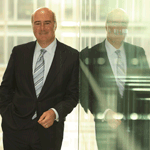When Chris Filandro joined Meritage Homes in 2003, the IT team was focused first on establishing a single system of record for finance, accounting, and operations, then on adding applications to distribute the information that system provides. Today, his team is all about leveraging that data.
“Enterprise-resource-planning technologies and bolt-on systems that provide critical information to sales, homebuilding operations, finance, and accounting are important, but today, it’s all about extending data in more of a lightweight format, such as cloud-computing solutions and mobile technologies, that are uniquely suitable to the functional area using them,” says Filandro, CIO of the Scottsdale, Arizona-based homebuilder with 163 active communities across the United States. “What we have to ask is, how do you leverage these technologies from a customer-facing perspective?”
The answer, Filandro says, starts in the back office, where IT gives the company an immediate holistic view—what’s happening in real time in terms of inventory, sales trends and pace, construction costs, and profit margins. That, in turn, allows Meritage Homes to make changes quickly. If sales data show that 80 percent of homebuyers are selecting 3 of 200 available options, for example, the company can change its products or pricing, thereby offering customers what they want at the most competitive prices.
Meritage Homes also uses technology to engage with the customer, as illustrated by the nine months IT spent developing a customized lead-management and sales tracking system with Salesforce.com. Today, customers who enter a local sales center are asked not to fill out an old-school registration card, but to answer a few questions on an iPad. “As soon as they submit the information, they receive a gift card, and we have information we can use to understand their needs and route them to the appropriate sales agent,” Filandro says. Meanwhile, customers who make contact via the company’s 800 number, which connects to a national contact center, are also transitioned to the appropriate sales agent based on their needs. The result is a holistic customer-engagement model in which all customer information, regardless of how it is obtained, is available on the same system. “It helps us better direct customers to products that really meet their needs, as opposed to them navigating through myriad communities, home plans, and options,” Filandro says.
To get his IT organization operating at this level, Filandro elevated senior business analysts to report directly to him. “These folks work for IT at the senior level, but they really understand the business and have tremendous relationships there,” explains Filandro, who adds that such a position is critical because IT must understand the enterprise. “A lot of people in IT will say something like, ‘With a cloud solution, you could save 30 percent,’” he adds. “But cloud solutions and other technologies are just tools in a technologist’s toolbox, and in order to select which ones make the most sense, you have to understand the company’s capital structure, business operating structure, short- and long-term strategy for growth, and revenue expansion and profit expansion.”
The change Filandro made has changed the IT request model, so employees seeking enhancements or new developments now reach out to the elevated business analysts, who vet those requests before sending them to his IT team. “Because my IT team isn’t triaging and vetting those requests, it can focus our time on developing and rolling out sophisticated technologies,” Filandro says. “It’s a different way of engaging with the business.”














